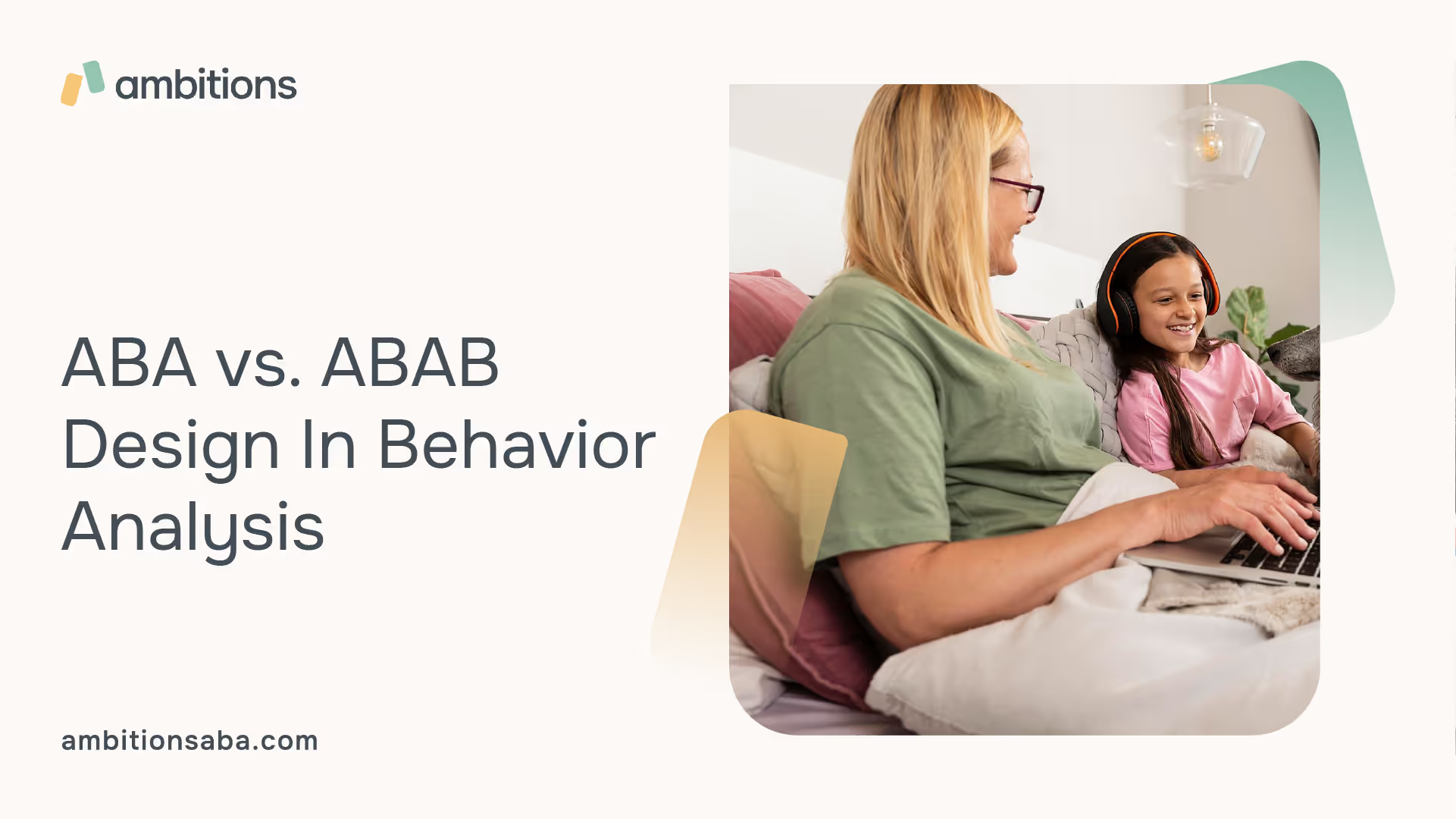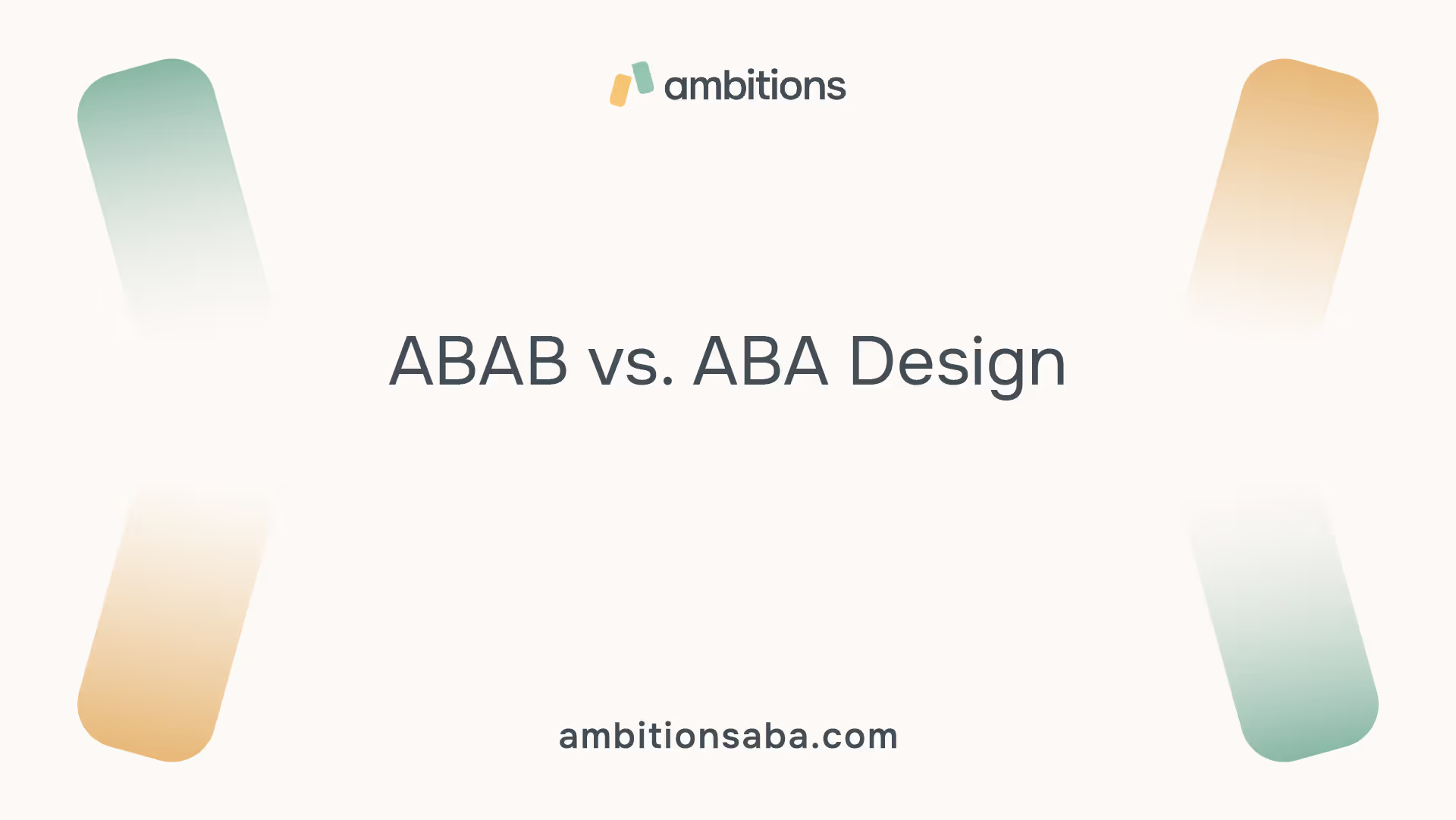Understanding ABA Therapy
ABA therapy, or Applied Behavior Analysis therapy, is a widely used approach for individuals with autism and other developmental disorders. This therapeutic method focuses on modifying behavioral issues through positive reinforcement and data-driven techniques. By understanding the basics of ABA therapy and its benefits, individuals and caregivers can make informed decisions about its implementation.

Basics of ABA Therapy
ABA therapy involves a systematic approach to behavior modification. Behavior analysts, who are trained professionals, utilize principles of behavior to address socially significant behaviors and improve the individual's quality of life. The core components of ABA therapy include:
- Observation and Assessment: A behavior analyst begins by observing and assessing the individual's behavior, identifying areas of concern and establishing a baseline. This baseline serves as a starting point to measure progress throughout the therapy.
- Intervention and Reinforcement: Based on the assessment, the behavior analyst designs and implements targeted interventions. These interventions typically involve positive reinforcement, which involves providing rewards or praise for desired behaviors. Reinforcement helps to increase the likelihood of the desired behavior occurring in the future.
- Data Collection and Analysis: Throughout the therapy process, data is collected to track progress and determine the effectiveness of interventions. Behavior analysts use various data collection methods such as direct observation, interviews, and questionnaires. This data allows them to make data-driven decisions and modify interventions as needed.
- Generalization and Maintenance: A key goal of ABA therapy is to promote generalization, which means applying the learned skills and behaviors in various settings and situations. Behavior analysts work with individuals and caregivers to ensure that the progress made in therapy is maintained over time and across different environments.
Benefits of ABA Therapy
ABA therapy offers several benefits for individuals with autism and their families. Some of the key advantages include:
- Skill Development: ABA therapy focuses on teaching new skills and promoting positive behaviors. This can include various areas such as communication, social skills, self-care, and academic skills.
- Behavior Reduction: ABA therapy aims to decrease challenging behaviors and replace them with more appropriate alternatives. This can include behaviors such as aggression, self-injury, or repetitive actions.
- Individualized Treatment: ABA therapy is highly individualized, tailored to meet the specific needs and goals of each individual. The therapy is based on comprehensive assessments and ongoing data collection, ensuring that interventions are personalized and effective.
- Collaboration and Support: ABA therapy often involves collaboration between behavior analysts, individuals, caregivers, and other professionals involved in the individual's care. This multidisciplinary approach provides a supportive network and enhances the effectiveness of the therapy.
- Long-Term Outcomes: ABA therapy has been shown to have long-term benefits, with many individuals experiencing significant improvements in behavior, communication, and daily functioning. These positive outcomes can have a lasting impact on the individual's independence and quality of life.
Understanding the basics and benefits of ABA therapy provides a foundation for individuals and caregivers considering this approach. By working closely with behavior analysts and implementing the principles of ABA, individuals with autism can make meaningful progress in their development and overall well-being.
ABAB vs. ABA Design
When it comes to applied behavior analysis (ABA) therapy, two commonly used research designs are the ABAB design and the ABA design. These designs serve as frameworks for studying and evaluating the effectiveness of interventions in behavior modification.

Introduction to ABAB Design
The ABAB design involves a systematic approach to behavior analysis. It consists of four stages: A (baseline), B (intervention), A (withdrawal of intervention), and B (reintroduction of intervention) [1]. In the first A phase, the behavior of interest is observed and recorded to establish a baseline. Then, in the B phase, an intervention is introduced to modify the behavior.
After a period of time, the intervention is withdrawn in the second A phase to observe if the behavior reverts to baseline levels. Finally, in the second B phase, the intervention is reintroduced to assess its impact on the behavior.
The ABAB design offers several advantages. It allows for repeated measurement and evaluation of the intervention's effects, providing a more comprehensive understanding of behavioral changes. Additionally, by reintroducing the intervention, the design helps assess the consistency and effectiveness of the intervention across multiple trials.
This method is often preferred by many ABA therapists as it allows for the repetition of the process, enabling clients to understand and feel more comfortable with the intervention.
Introduction to ABA Design
The ABA design, also known as the reversal design, is another commonly used research design in ABA therapy. It involves a simplified version of the ABAB design, consisting of three stages: A (baseline), B (intervention), and A (withdrawal of intervention). In this design, the behavior is observed and recorded during the A phase to establish a baseline.
Then, an intervention is introduced during the B phase to modify the behavior. Finally, the intervention is withdrawn in the second A phase to assess whether the behavior returns to baseline levels.
While the ABA design may not provide the same level of repeated measurement and evaluation as the ABAB design, it is still a valuable tool in behavior analysis. It allows for the examination of changes in behavior when the intervention is present versus when it is absent. By comparing the baseline phase with the intervention phase, researchers can gain insights into the effectiveness of the intervention.
Both the ABAB design and the ABA design have their merits and limitations. The ABAB design is often considered superior to the ABA design because it provides stronger evidence of the treatment's effectiveness. The repeated introduction and withdrawal of the intervention allow for a more comprehensive understanding of behavior changes.
However, the ABA design can still provide valuable insights into the impact of interventions on behavior, especially when the ABAB design is not feasible or ethical [1].
In the next sections, we will explore the practical application of the ABAB design in ABA therapy, including its implementation and evaluation of interventions. We will also examine case studies that highlight the effectiveness of the ABAB design in practice.
Applying ABAB Design in ABA Therapy
In the field of Applied Behavior Analysis (ABA) therapy, the ABAB design is a commonly utilized approach for implementing and evaluating interventions. This design allows therapists to gather valuable information about the effectiveness of interventions and make data-driven decisions to promote positive behavior change.

Implementing ABAB Design
The ABAB design involves two parts: baseline measurement and treatment implementation. During the baseline phase, the therapist gathers information on the behavior that needs to be changed [1]. This baseline data provides a benchmark against which the effects of the treatment can be measured.
Following the baseline phase, the treatment is introduced (Phase A). The therapist implements the intervention and observes changes in the behavior. This is known as the treatment phase. The treatment is then temporarily removed (Phase B) to evaluate whether the changes in behavior were a result of the intervention or other factors.
After the treatment is withdrawn, the therapist reintroduces it (Phase A again) to determine if the behavior changes observed in the initial treatment phase recur. This allows for a comparison of behavior between the treatment and non-treatment phases, providing valuable insights into the effectiveness of the intervention.
Evaluating Interventions with ABAB Design
The ABAB design offers several advantages in evaluating interventions in ABA therapy. Firstly, it allows therapists to assess the effects of the treatment by directly comparing the behavior during the treatment phase with the behavior during the non-treatment phase. This comparison provides stronger evidence of the treatment's effectiveness.
Additionally, the ABAB design method provides an opportunity for repeated processes, allowing the client to better understand and become more comfortable with the intervention [1]. This repeated exposure to the treatment helps therapists gather more information and refine their approach without having to start the process from scratch. It also helps identify the most effective intervention without the need for constant restarts [1].
By employing the ABAB design in ABA therapy, therapists can gain a comprehensive understanding of the impact of interventions on behavior. This approach provides valuable insights that inform treatment decisions and help individuals with autism and their caregivers achieve positive outcomes.
Case Studies Using ABAB Design
The ABAB design is a valuable method used in applied behavior analysis (ABA) to assess the effectiveness of interventions. This design involves alternating phases of intervention and baseline measurements, allowing researchers to evaluate the impact of the intervention on behavior. Let's explore the effectiveness of ABAB design and its practical application in ABA therapy.
Effectiveness of ABAB Design
The ABAB design is based on the principle of experimental control, providing researchers with a systematic way to manipulate interventions and observe their effects. This design allows for the assessment of whether the behavior changes when the intervention is introduced and whether it reverts back to the baseline level when the intervention is withdrawn [2]. By collecting data during each phase, researchers can measure the target behavior and analyze the effectiveness of the intervention.
One advantage of the ABAB design is that it allows researchers to evaluate the strength of the intervention by reintroducing it after returning to the baseline. This helps determine if there is a functional relationship between the intervention and the behavior. Additionally, the ABAB design provides a more comprehensive understanding of the intervention's impact by considering the potential changes in behavior over time as the individual becomes accustomed to the intervention.
ABAB Design in Practice
In ABA therapy, the ABAB design is often preferred by therapists due to its advantages in gathering data and evaluating interventions. This approach allows therapists to repeatedly implement and withdraw interventions, helping clients understand and become more comfortable with the process [1]. By utilizing the ABAB design, therapists gain valuable insights into the effectiveness of interventions without starting the process from scratch each time.
The ABAB design also provides a sense of closure as it ends on a positive note with the intervention in place, unlike the ABA design where the intervention is withdrawn at the end of the study. This can be particularly beneficial for clients, as it maintains the positive impact of the intervention and supports their progress.
By conducting case studies using the ABAB design, researchers and therapists can gather meaningful data, assess the effectiveness of interventions, and make informed decisions about the best course of action for their clients. The ABAB design plays a vital role in advancing the field of ABA therapy and improving outcomes for individuals with diverse behavioral needs.
Ethical Considerations
When it comes to ABA therapy, it's essential to consider the ethical implications and concerns surrounding its practice. Here, we will explore some of the ethical concerns in ABA therapy and discuss the ethical applications of ABAB design.
Ethical Concerns in ABA Therapy
While ABA therapy has proven to be effective in addressing behavioral challenges and promoting skill development, there are ethical considerations that need to be taken into account. One of the major ethical concerns is the practice of identifying a successful intervention and then withdrawing it. This can pose ethical dilemmas, especially when it is unsafe or unethical to revert an individual back to their baseline condition.
Additionally, the use of the ABA and ABAB design models raises concerns about the potential for history effects. If the dependent variable does not return to its original state when the treatment or therapy is removed, it becomes challenging to rule out the influence of prior interventions or external factors.
These ethical concerns highlight the importance of carefully considering the appropriateness of ABA therapy in specific situations and ensuring that the well-being and safety of the individual receiving therapy are prioritized.
Ethical Applications of ABAB Design
Despite the ethical concerns associated with ABA therapy and the ABAB design, the ABAB design is often preferred by many ABA therapists due to its benefits and ethical applications. One advantage of the ABAB design is that it allows for multiple reversals, providing a stronger design and additional control over the experimental process [3].
By reintroducing the intervention after returning to the baseline, the ABAB design helps determine the strength of the intervention and assess the functional relationship between different variables.
From an ethical standpoint, the ABAB design method provides therapists with more information and helps identify the most effective interventions for individuals without having to start the process from scratch. This repeated process allows clients to understand and become more comfortable with the intervention, ultimately leading to better outcomes.
By using the ABAB design, therapists can gather valuable data and make informed decisions about the most appropriate and effective interventions for their clients.
When employing ABA therapy and the ABAB design, it is crucial for therapists to approach the process with ethical considerations in mind. Open communication, informed consent, and a focus on the well-being and autonomy of the individual receiving therapy should guide the ethical implementation of these techniques.
By adhering to ethical guidelines and continuously evaluating the ethical implications of their practice, ABA therapists can ensure that they provide effective and ethical care to their clients.
Choosing the Right Approach
When it comes to selecting the appropriate design for applied behavior analysis (ABA) therapy, there are two main options to consider: ABA and ABAB design. Each design has its own advantages and considerations, and the choice depends on various factors related to the individual and their specific needs.
ABA vs. ABAB: Selecting the Design
ABA design, also known as the single-case experimental design, involves implementing and evaluating a single intervention for an individual. This design typically follows a straightforward process of implementing the intervention and measuring the individual's response to determine its effectiveness. If the intervention proves to be successful, it can be continued, but if it is ineffective, new intervention ideas may need to be explored.
ABA design is often used when trying to identify the function of a behavior or when testing the effectiveness of a specific intervention.
On the other hand, ABAB design, also known as the reversal or withdrawal design, involves implementing and withdrawing the intervention multiple times to observe changes in behavior. This design allows for repeated processes, helping clients understand and become more comfortable with the intervention. It provides therapists with more information and helps identify the most effective intervention without having to start the process from scratch.
ABAB design is often preferred by many ABA therapists as it provides stronger evidence of the treatment's effectiveness. The intervention typically works faster the second time it is reintroduced, allowing for a clearer understanding of its impact.
Factors Influencing Design Choice
Several factors can influence the choice between ABA and ABAB design in ABA therapy. Some of these factors include:
- Research Goals: Consider the specific research goals or objectives of the therapy. ABA design may be more suitable when trying to identify the function of a behavior, while ABAB design may be more appropriate for evaluating the effectiveness of an intervention.
- Client Comfort: Take into account the comfort level and understanding of the individual receiving therapy. ABAB design allows for repetition, which can help the client become familiar with the intervention and potentially improve their response to it.
- Data Collection: Evaluate the feasibility of collecting and analyzing data. ABAB design requires repeated implementation and withdrawal of the intervention, which may require more effort and resources for data collection and analysis.
- Practical Considerations: Consider practical considerations such as time, resources, and the availability of alternative interventions. ABA design may be more suitable if there are limited resources or time constraints, while ABAB design allows for a more in-depth evaluation of the intervention's effectiveness.
When choosing between ABA and ABAB design in ABA therapy, it is essential to consider these factors in conjunction with the specific needs and goals of the individual receiving therapy. Collaboration with an experienced ABA therapist can help determine the most appropriate approach for maximizing the effectiveness of the intervention.
Remember, the ultimate goal of ABA therapy is to promote positive behavior change and improve the lives of individuals with autism. By selecting the right design and implementing evidence-based interventions, ABA therapists can make significant strides in helping individuals reach their full potential.
References
[1]: https://www.crossrivertherapy.com/aba-therapists/aba-vs-abab-design
[2]: https://www.goldstarrehab.com/parent-resources/aba-vs-abab-design-in-applied-behavior-analysis
[3]: https://www.appliedbehavioranalysisprograms.com/faq/what-is-the-a-b-a-design-in-applied-behavior-analysis/



